
USGS/SLU Moment Tensor Solution
ENS 2021/08/13 11:57:35:0 35.88 -84.90 1.0 3.5 Tennessee
Stations used:
CO.CASEE CO.HODGE CO.PAULI ET.CPCT IM.TKL IU.WCI IU.WVT
N4.R49A N4.R50A N4.S51A N4.T47A N4.T50A N4.U49A N4.V48A
N4.V53A N4.V55A N4.W50A N4.W52A N4.X48A N4.X51A N4.Y52A
NM.BLO NM.USIN US.GOGA US.LRAL US.TZTN
Filtering commands used:
cut o DIST/3.3 -40 o DIST/3.3 +50
rtr
taper w 0.1
hp c 0.03 n 3
lp c 0.10 n 3
Best Fitting Double Couple
Mo = 1.26e+22 dyne-cm
Mw = 4.00
Z = 1 km
Plane Strike Dip Rake
NP1 65 80 93
NP2 230 10 75
Principal Axes:
Axis Value Plunge Azimuth
T 1.26e+22 55 338
N 0.00e+00 3 245
P -1.26e+22 35 153
Moment Tensor: (dyne-cm)
Component Value
Mxx -3.00e+21
Mxy 1.95e+21
Mxz 1.08e+22
Myy -1.16e+21
Myz -4.89e+21
Mzz 4.16e+21
--------------
----#################-
----#######################-
--############################
--################################
--########### ####################
--############ T ####################-
--############# ##################----
-#################################------
--##############################----------
--##########################--------------
-########################-----------------
-####################---------------------
-###############------------------------
-#########------------------------------
-##-----------------------------------
----------------------- ----------
---------------------- P ---------
-------------------- -------
----------------------------
----------------------
--------------
Global CMT Convention Moment Tensor:
R T P
4.16e+21 1.08e+22 4.89e+21
1.08e+22 -3.00e+21 -1.95e+21
4.89e+21 -1.95e+21 -1.16e+21
Details of the solution is found at
http://www.eas.slu.edu/eqc/eqc_mt/MECH.NA/20210813115735/index.html
|
STK = 230
DIP = 10
RAKE = 75
MW = 4.00
HS = 1.0
The NDK file is 20210813115735.ndk The waveform inversion is preferred.
The following compares this source inversion to others
USGS/SLU Moment Tensor Solution
ENS 2021/08/13 11:57:35:0 35.88 -84.90 1.0 3.5 Tennessee
Stations used:
CO.CASEE CO.HODGE CO.PAULI ET.CPCT IM.TKL IU.WCI IU.WVT
N4.R49A N4.R50A N4.S51A N4.T47A N4.T50A N4.U49A N4.V48A
N4.V53A N4.V55A N4.W50A N4.W52A N4.X48A N4.X51A N4.Y52A
NM.BLO NM.USIN US.GOGA US.LRAL US.TZTN
Filtering commands used:
cut o DIST/3.3 -40 o DIST/3.3 +50
rtr
taper w 0.1
hp c 0.03 n 3
lp c 0.10 n 3
Best Fitting Double Couple
Mo = 1.26e+22 dyne-cm
Mw = 4.00
Z = 1 km
Plane Strike Dip Rake
NP1 65 80 93
NP2 230 10 75
Principal Axes:
Axis Value Plunge Azimuth
T 1.26e+22 55 338
N 0.00e+00 3 245
P -1.26e+22 35 153
Moment Tensor: (dyne-cm)
Component Value
Mxx -3.00e+21
Mxy 1.95e+21
Mxz 1.08e+22
Myy -1.16e+21
Myz -4.89e+21
Mzz 4.16e+21
--------------
----#################-
----#######################-
--############################
--################################
--########### ####################
--############ T ####################-
--############# ##################----
-#################################------
--##############################----------
--##########################--------------
-########################-----------------
-####################---------------------
-###############------------------------
-#########------------------------------
-##-----------------------------------
----------------------- ----------
---------------------- P ---------
-------------------- -------
----------------------------
----------------------
--------------
Global CMT Convention Moment Tensor:
R T P
4.16e+21 1.08e+22 4.89e+21
1.08e+22 -3.00e+21 -1.95e+21
4.89e+21 -1.95e+21 -1.16e+21
Details of the solution is found at
http://www.eas.slu.edu/eqc/eqc_mt/MECH.NA/20210813115735/index.html
|
Moment (dyne-cm) 2.08E+22 dyne-cm
Magnitude (Mw) 4.15
Depth 1 km
Principal Axes:
Axis Value Plunge Azimuth
T -4.94E+21 29. 19.
N -1.07E+22 1. 288.
P -2.69E+22 61. 197.
Moment Tensor: (dyne-cm) Aki-Richards Lune parameters
Component Value
Mxx -1.01E+22 beta: 146.76
Mxy 3.00E+20 gamma: 15.29
Mxz 8.80E+21
Myy -1.06E+22
Myz 2.80E+21
Mzz -2.19E+22
Global CMT Convention Moment Tensor: (dyne-cm)
R T F
R -2.19E+22 8.80E+21 -2.80E+21
T 8.80E+21 -1.01E+22 -3.00E+20
F -2.80E+21 -3.00E+20 -1.06E+22
-------------- :
---------------------- :---:
----------------- -------- ::. ..::
------------------ T --------- :--------:
-------------------- ----------- :: . . . :
------------------------------------ : . . . :
-------------------------------------- :------------::
---------------------------------------- :: . . . :
---------------------------------------- : . . . :
------------------------------------------ :---------------:
------------------------------------------ : . . . :
------------------------------------------ :===============:
------------------------------------------ : . . . :
---------------- --------------------- : . . . :
---------------- P --------------------- :---------------:
--------------- -------------------- : . . . :
------------------------------------ :: . . . :
---------------------------------- :------------::
------------------------------ : . . . :
---------------------------- :: . . # :
---------------------- :--------:
-------------- ::. ..::
:---:
:
|
Moment (dyne-cm) 1.26E+22 dyne-cm
Magnitude (Mw) 4.00
Depth 1.0 km
Principal Axes:
Axis Value Plunge Azimuth
T 1.26E+22 55. 338.
N 7.07E+17 3. 245.
P -1.26E+22 35. 153.
Moment Tensor: (dyne-cm) Aki-Richards Lune parameters
Component Value
Mxx -3.01E+21 beta: 90.00
Mxy 1.95E+21 gamma: 0.00
Mxz 1.08E+22
Myy -1.16E+21
Myz -4.90E+21
Mzz 4.17E+21
Global CMT Convention Moment Tensor: (dyne-cm)
R T F
R 4.17E+21 1.08E+22 4.90E+21
T 1.08E+22 -3.01E+21 -1.95E+21
F 4.90E+21 -1.95E+21 -1.16E+21
-------------- :
----#################- :---:
----#######################- ::. ..::
--############################ :--------:
--################################ :: . . . :
--########### #################### : . . . :
--############ T ####################- :------------::
--############# ##################---- :: . . . :
-#################################------ : . . . :
--##############################---------- :---------------:
--##########################-------------- : . . . :
-########################----------------- :=======#=======:
-####################--------------------- : . . . :
-###############------------------------ : . . . :
-##########----------------------------- :---------------:
-##----------------------------------- : . . . :
----------------------- ---------- :: . . . :
---------------------- P --------- :------------::
-------------------- ------- : . . . :
---------------------------- :: . . . :
---------------------- :--------:
-------------- ::. ..::
:---:
:
|
Moment (dyne-cm) 1.40E+22 dyne-cm
Magnitude (Mw) 4.03
Depth 1.0 km
Principal Axes:
Axis Value Plunge Azimuth
T 1.55E+22 55. 7.
N -3.86E+21 2. 275.
P -1.16E+22 35. 184.
Moment Tensor: (dyne-cm) Aki-Richards Lune parameters
Component Value
Mxx -2.71E+21 beta: 90.00
Mxy 4.82E+20 gamma: -13.85
Mxz 1.27E+22
Myy -3.78E+21
Myz 1.39E+21
Mzz 6.49E+21
Global CMT Convention Moment Tensor: (dyne-cm)
R T F
R 6.49E+21 1.27E+22 -1.39E+21
T 1.27E+22 -2.71E+21 -4.82E+20
F -1.39E+21 -4.82E+20 -3.78E+21
-----#####---- :
---#################-- :---:
---#######################-- ::. ..::
---##########################- :--------:
---#############################-- :: . . . :
---############### #############-- : . . . :
----############### T ##############-- :------------::
-----############### ##############--- :: . . . :
-----################################--- : . . . :
-------##############################----- :---------------:
---------###########################------ : . . . :
-----------########################------- :===#===========:
----------------###############----------- : . . . :
---------------------------------------- : . . . :
---------------------------------------- :---------------:
-------------------------------------- : . . . :
------------------------------------ :: . . . :
--------------- ---------------- :------------::
------------- P -------------- : . . . :
------------ ------------- :: . . . :
---------------------- :--------:
-------------- ::. ..::
:---:
:
|
Moment (dyne-cm) 1.72E+22 dyne-cm
Magnitude (Mw) 4.09
Depth 1.0 km
Principal Axes:
Axis Value Plunge Azimuth
T -2.01E+21 35. 20.
N -9.33E+21 -0. 290.
P -2.24E+22 55. 200.
Moment Tensor: (dyne-cm) Aki-Richards Lune parameters
Component Value
Mxx -8.78E+21 beta: 143.14
Mxy 2.01E+20 gamma: 9.23
Mxz 9.00E+21
Myy -9.26E+21
Myz 3.27E+21
Mzz -1.57E+22
Global CMT Convention Moment Tensor: (dyne-cm)
R T F
R -1.57E+22 9.00E+21 -3.27E+21
T 9.00E+21 -8.78E+21 -2.01E+20
F -3.27E+21 -2.01E+20 -9.26E+21
-------------- :
---------------------- :---:
---------------------------- ::. ..::
------------------ --------- :--------:
-------------------- T ----------- :: . . . :
--------------------- ------------ : . . . :
-------------------------------------- :------------::
---------------------------------------- :: . . . :
---------------------------------------- : . . . :
------------------------------------------ :---------------:
------------------------------------------ : . . . :
------------------------------------------ :===============:
------------------------------------------ : . . . :
---------------------------------------- : . . . :
--------------- ---------------------- :---------------:
-------------- P --------------------- : . . . :
------------- -------------------- :: . . . :
---------------------------------- :------------::
------------------------------ : . . . :
---------------------------- :: . .#. :
---------------------- :--------:
-------------- ::. ..::
:---:
:
|
Moment (dyne-cm) 2.08E+22 dyne-cm
Magnitude (Mw) 4.15
Depth 1.0 km
Principal Axes:
Axis Value Plunge Azimuth
T -4.94E+21 29. 19.
N -1.07E+22 1. 288.
P -2.69E+22 61. 197.
Moment Tensor: (dyne-cm) Aki-Richards Lune parameters
Component Value
Mxx -1.01E+22 beta: 146.76
Mxy 3.00E+20 gamma: 15.29
Mxz 8.80E+21
Myy -1.06E+22
Myz 2.80E+21
Mzz -2.19E+22
Global CMT Convention Moment Tensor: (dyne-cm)
R T F
R -2.19E+22 8.80E+21 -2.80E+21
T 8.80E+21 -1.01E+22 -3.00E+20
F -2.80E+21 -3.00E+20 -1.06E+22
-------------- :
---------------------- :---:
----------------- -------- ::. ..::
------------------ T --------- :--------:
-------------------- ----------- :: . . . :
------------------------------------ : . . . :
-------------------------------------- :------------::
---------------------------------------- :: . . . :
---------------------------------------- : . . . :
------------------------------------------ :---------------:
------------------------------------------ : . . . :
------------------------------------------ :===============:
------------------------------------------ : . . . :
---------------- --------------------- : . . . :
---------------- P --------------------- :---------------:
--------------- -------------------- : . . . :
------------------------------------ :: . . . :
---------------------------------- :------------::
------------------------------ : . . . :
---------------------------- :: . . # :
---------------------- :--------:
-------------- ::. ..::
:---:
:
|
Moment (dyne-cm) 1.43E+22 dyne-cm
Magnitude (Mw) 4.04
Depth 1.0 km
Principal Axes:
Axis Value Plunge Azimuth
T 1.58E+22 55. 15.
N -3.78E+21 1. 283.
P -1.20E+22 35. 192.
Moment Tensor: (dyne-cm) Aki-Richards Lune parameters
Component Value
Mxx -2.84E+21 beta: 90.00
Mxy 4.45E+20 gamma: -13.26
Mxz 1.27E+22
Myy -3.62E+21
Myz 3.16E+21
Mzz 6.46E+21
Global CMT Convention Moment Tensor: (dyne-cm)
R T F
R 6.46E+21 1.27E+22 -3.16E+21
T 1.27E+22 -2.84E+21 -4.45E+20
F -3.16E+21 -4.45E+20 -3.62E+21
-----#####---- :
---#################-- :---:
----######################-- ::. ..::
---##########################- :--------:
----############################-- :: . . . :
----############### ############-- : . . . :
-----############### T #############-- :------------::
------############### #############--- :: . . . :
------################################-- : . . . :
---------#############################---- :---------------:
-----------###########################---- : . . . :
--------------#######################----- :===#===========:
------------------################-------- : . . . :
---------------------------------------- : . . . :
---------------------------------------- :---------------:
-------------------------------------- : . . . :
------------------------------------ :: . . . :
------------- ------------------ :------------::
----------- P ---------------- : . . . :
---------- --------------- :: . . . :
---------------------- :--------:
-------------- ::. ..::
:---:
:
|
 |
The focal mechanism was determined using broadband seismic waveforms. The location of the event and the and stations used for the waveform inversion are shown in the next figure.

|
|
|
The program wvfgrd96 was used with good traces observed at short distance to determine the focal mechanism, depth and seismic moment. This technique requires a high quality signal and well determined velocity model for the Green functions. To the extent that these are the quality data, this type of mechanism should be preferred over the radiation pattern technique which requires the separate step of defining the pressure and tension quadrants and the correct strike.
The observed and predicted traces are filtered using the following gsac commands:
cut o DIST/3.3 -40 o DIST/3.3 +50 rtr taper w 0.1 hp c 0.03 n 3 lp c 0.10 n 3The results of this grid search from 0.5 to 19 km depth are as follow:
DEPTH STK DIP RAKE MW FIT
WVFGRD96 1.0 230 10 75 4.00 0.7748
WVFGRD96 2.0 230 15 75 3.89 0.7145
WVFGRD96 3.0 230 15 75 3.83 0.6444
WVFGRD96 4.0 220 15 65 3.78 0.5976
WVFGRD96 5.0 200 15 45 3.75 0.5721
The best solution is
WVFGRD96 1.0 230 10 75 4.00 0.7748
The mechanism correspond to the best fit is
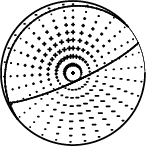
|
|
|
The best fit as a function of depth is given in the following figure:
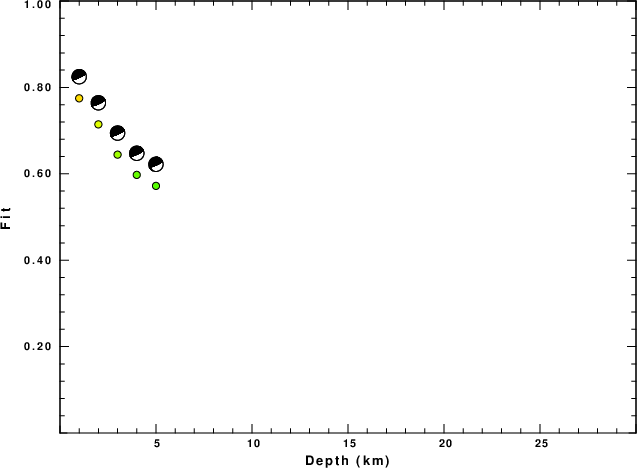
|
|
|
The comparison of the observed and predicted waveforms is given in the next figure. The red traces are the observed and the blue are the predicted. Each observed-predicted component is plotted to the same scale and peak amplitudes are indicated by the numbers to the left of each trace. A pair of numbers is given in black at the right of each predicted traces. The upper number it the time shift required for maximum correlation between the observed and predicted traces. This time shift is required because the synthetics are not computed at exactly the same distance as the observed and because the velocity model used in the predictions may not be perfect. A positive time shift indicates that the prediction is too fast and should be delayed to match the observed trace (shift to the right in this figure). A negative value indicates that the prediction is too slow. The lower number gives the percentage of variance reduction to characterize the individual goodness of fit (100% indicates a perfect fit).
The bandpass filter used in the processing and for the display was
cut o DIST/3.3 -40 o DIST/3.3 +50 rtr taper w 0.1 hp c 0.03 n 3 lp c 0.10 n 3

|
|
|
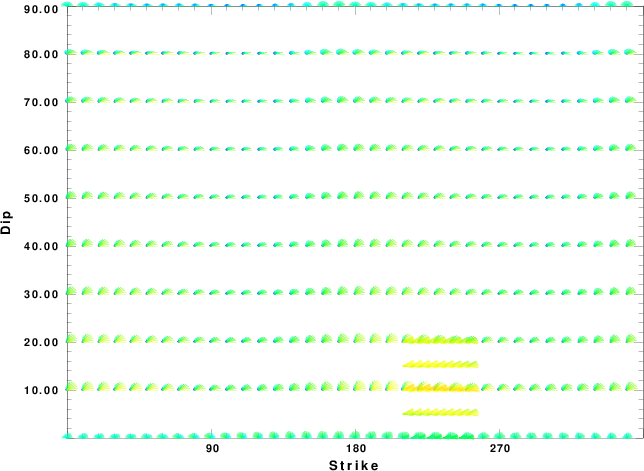
|
| Focal mechanism sensitivity at the preferred depth. The red color indicates a very good fit to thewavefroms. Each solution is plotted as a vector at a given value of strike and dip with the angle of the vector representing the rake angle, measured, with respect to the upward vertical (N) in the figure. |
A check on the assumed source location is possible by looking at the time shifts between the observed and predicted traces. The time shifts for waveform matching arise for several reasons:
Time_shift = A + B cos Azimuth + C Sin Azimuth
The time shifts for this inversion lead to the next figure:

The derived shift in origin time and epicentral coordinates are given at the bottom of the figure.
The focal mechanism was determined using broadband seismic waveforms. The location of the event and the and stations used for the waveform inversion are shown in the next figure.

|
|
|
The program wvfmtd96 was used with good traces observed at short distance to determine the focal mechanism, depth and seismic moment. This technique requires a high quality signal and well determined velocity model for the Green functions. To the extent that these are the quality data, this type of mechanism should be preferred over the radiation pattern technique which requires the separate step of defining the pressure and tension quadrants and the correct strike.
The observed and predicted traces are filtered using the following gsac commands:
cut o DIST/3.3 -40 o DIST/3.3 +50 rtr taper w 0.1 hp c 0.03 n 3 lp c 0.10 n 3The results of this grid search over depth are as follow:
MT Program H(km) Mw Fit Mxx(dyne-cm) Myy Mxy Mxz Myz Mzz WVFMTD961 1.0 103. 80. 91. 4.04 0.930 0.318E-07 0.928 0.964 0.253E-07 47.9 -0.2843026E+22 -0.3620183E+22 0.4454430E+21 0.1273254E+23 0.3155309E+22 0.6463209E+22 WVFMTD961 2.0 104. 73. 93. 3.95 0.790 0.550E-07 0.779 0.889 0.444E-07 74.5 -0.3482789E+22 -0.4207324E+22 0.6089934E+21 0.7724496E+22 0.2375683E+22 0.7690113E+22 WVFMTD961 3.0 100. 73. 98. 3.89 0.633 0.729E-07 0.619 0.796 0.584E-07 77.8 -0.2694129E+22 -0.3316760E+22 0.1034962E+22 0.6207957E+22 0.2232103E+22 0.6010889E+22 WVFMTD961 4.0 296. 62. -98. 3.81 0.346 0.971E-07 0.349 0.588 0.762E-07 46.5 0.3346578E+22 0.2677260E+22 0.1508864E+22 0.3421390E+22 0.8482498E+21 -0.6023838E+22 WVFMTD961 5.0 302. 53. -93. 3.88 0.527 0.825E-07 0.521 0.726 0.653E-07 73.9 0.4819937E+22 0.4195446E+22 0.1045229E+22 0.2058308E+22 0.6715092E+21 -0.9015383E+22
The best solution is
WVFMTD961 1.0 103. 80. 91. 4.04 0.930 0.318E-07 0.928 0.964 0.253E-07 47.9 -0.2843026E+22 -0.3620183E+22 0.4454430E+21 0.1273254E+23 0.3155309E+22 0.6463209E+22
The complete moment tensor decomposition using the program mtdinfo is given in the text file MTDinfo.txt. (Jost, M. L., and R. B. Herrmann (1989). A student's guide to and review of moment tensors, Seism. Res. Letters 60, 37-57. SRL_60_2_37-57.pdf.
The P-wave first motion mechanism corresponding to the best fit is

|
|
|
The best fit as a function of depth is given in the following figure:
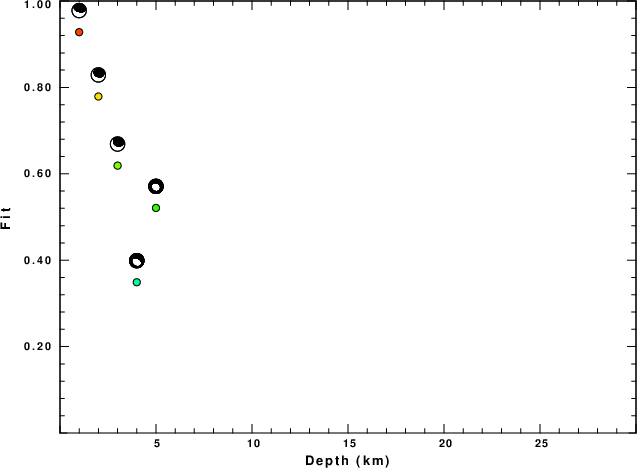
|
|
|
The comparison of the observed and predicted waveforms is given in the next figure. The red traces are the observed and the blue are the predicted. Each observed-predicted component is plotted to the same scale and peak amplitudes are indicated by the numbers to the left of each trace. A pair of numbers is given in black at the right of each predicted traces. The upper number it the time shift required for maximum correlation between the observed and predicted traces. This time shift is required because the synthetics are not computed at exactly the same distance as the observed and because the velocity model used in the predictions may not be perfect. A positive time shift indicates that the prediction is too fast and should be delayed to match the observed trace (shift to the right in this figure). A negative value indicates that the prediction is too slow. The lower number gives the percentage of variance reduction to characterize the individual goodness of fit (100% indicates a perfect fit).
The bandpass filter used in the processing and for the display was
cut o DIST/3.3 -40 o DIST/3.3 +50 rtr taper w 0.1 hp c 0.03 n 3 lp c 0.10 n 3
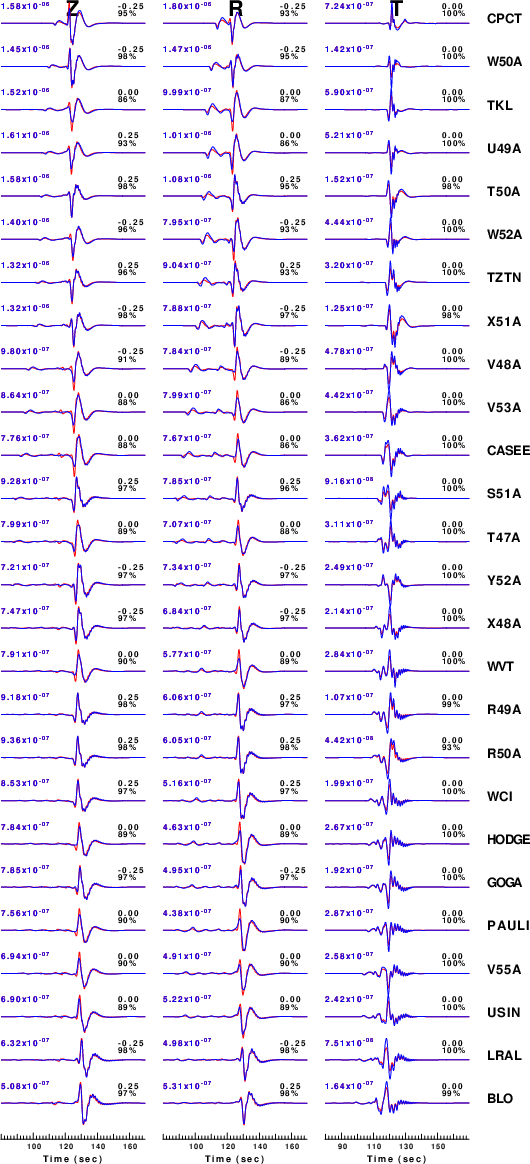
|
|
|
A check on the assumed source location is possible by looking at the time shifts between the observed and predicted traces. The time shifts for waveform matching arise for several reasons:
Time_shift = A + B cos Azimuth + C Sin Azimuth
The time shifts for this inversion lead to the next figure:

The derived shift in origin time and epicentral coordinates are given at the bottom of the figure.
The focal mechanism was determined using broadband seismic waveforms. The location of the event and the and stations used for the waveform inversion are shown in the next figure.

|
|
|
The program wvfmt96 was used with good traces observed at short distance to determine the focal mechanism, depth and seismic moment. This technique requires a high quality signal and well determined velocity model for the Green functions. To the extent that these are the quality data, this type of mechanism should be preferred over the radiation pattern technique which requires the separate step of defining the pressure and tension quadrants and the correct strike.
The observed and predicted traces are filtered using the following gsac commands:
cut o DIST/3.3 -40 o DIST/3.3 +50 rtr taper w 0.1 hp c 0.03 n 3 lp c 0.10 n 3The results of this grid search over depth are as follow:
MT Program H(km) Mw Fit Mxx(dyne-cm) Myy Mxy Mxz Myz Mzz WVFMT961 1.0 288. 74. -91. 4.15 1.000 0.184E-12 1.000 1.000 0.147E-12 54.5 -0.1010000E+23 -0.1060000E+23 0.3000005E+21 0.8799995E+22 0.2799998E+22 -0.2190000E+23 WVFMT961 2.0 290. 65. -91. 4.08 0.988 0.133E-07 0.987 0.994 0.107E-07 68.8 -0.8465412E+22 -0.9118889E+22 0.3790051E+21 0.4120273E+22 0.1348096E+22 -0.1872178E+23 WVFMT961 3.0 290. 61. -91. 4.05 0.968 0.214E-07 0.967 0.984 0.172E-07 71.5 -0.7464658E+22 -0.8292816E+22 0.4225719E+21 0.2987755E+22 0.9642471E+21 -0.1741766E+23 WVFMT961 4.0 291. 59. -91. 4.03 0.944 0.283E-07 0.942 0.972 0.227E-07 73.1 -0.6713553E+22 -0.7515828E+22 0.4639834E+21 0.2481360E+22 0.7933492E+21 -0.1647908E+23 WVFMT961 5.0 291. 58. -91. 4.01 0.918 0.343E-07 0.915 0.958 0.275E-07 75.8 -0.6053040E+22 -0.6824195E+22 0.4018019E+21 0.2201268E+22 0.6953245E+21 -0.1570855E+23
The best solution is
WVFMT961 1.0 288. 74. -91. 4.15 1.000 0.184E-12 1.000 1.000 0.147E-12 54.5 -0.1010000E+23 -0.1060000E+23 0.3000005E+21 0.8799995E+22 0.2799998E+22 -0.2190000E+23
The complete moment tensor decomposition using the program mtinfo is given in the text file MTinfo.txt. (Jost, M. L., and R. B. Herrmann (1989). A student's guide to and review of moment tensors, Seism. Res. Letters 60, 37-57. SRL_60_2_37-57.pdf.
The P-wave first motion mechanism corresponding to the best fit is

|
|
|
The best fit as a function of depth is given in the following figure:

|
|
|
The comparison of the observed and predicted waveforms is given in the next figure. The red traces are the observed and the blue are the predicted. Each observed-predicted component is plotted to the same scale and peak amplitudes are indicated by the numbers to the left of each trace. A pair of numbers is given in black at the right of each predicted traces. The upper number it the time shift required for maximum correlation between the observed and predicted traces. This time shift is required because the synthetics are not computed at exactly the same distance as the observed and because the velocity model used in the predictions may not be perfect. A positive time shift indicates that the prediction is too fast and should be delayed to match the observed trace (shift to the right in this figure). A negative value indicates that the prediction is too slow. The lower number gives the percentage of variance reduction to characterize the individual goodness of fit (100% indicates a perfect fit).
The bandpass filter used in the processing and for the display was
cut o DIST/3.3 -40 o DIST/3.3 +50 rtr taper w 0.1 hp c 0.03 n 3 lp c 0.10 n 3
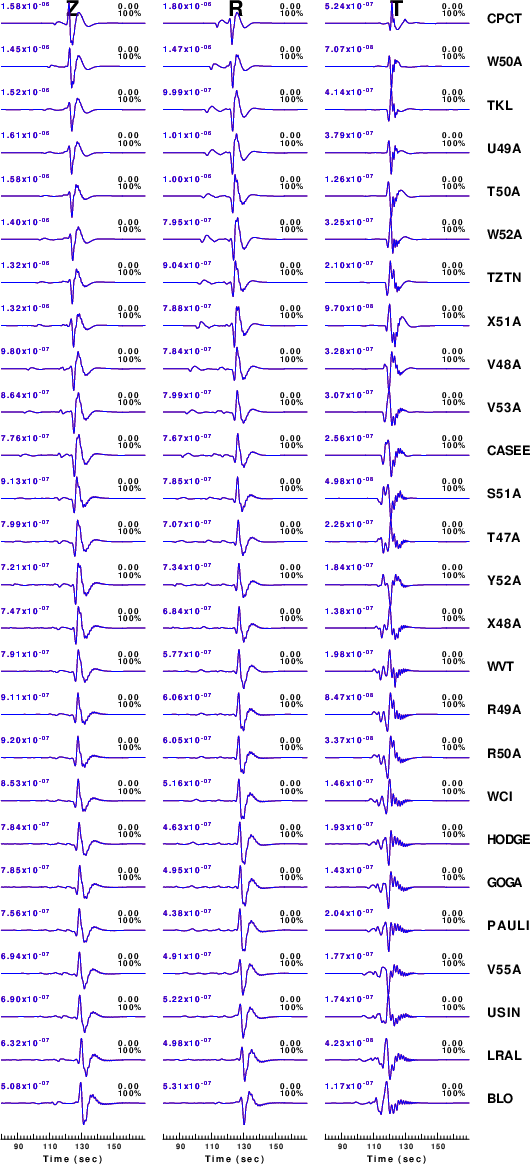
|
|
|
A check on the assumed source location is possible by looking at the time shifts between the observed and predicted traces. The time shifts for waveform matching arise for several reasons:
Time_shift = A + B cos Azimuth + C Sin Azimuth
The time shifts for this inversion lead to the next figure:

The derived shift in origin time and epicentral coordinates are given at the bottom of the figure.
The focal mechanism was determined using broadband seismic waveforms. The location of the event and the and stations used for the waveform inversion are shown in the next figure.

|
|
|
The program wvfmtgrd96 was used with good traces observed at short distance to determine the focal mechanism, depth and seismic moment. This technique requires a high quality signal and well determined velocity model for the Green functions. To the extent that these are the quality data, this type of mechanism should be preferred over the radiation pattern technique which requires the separate step of defining the pressure and tension quadrants and the correct strike.
The observed and predicted traces are filtered using the following gsac commands:
cut o DIST/3.3 -20 o DIST/3.3 +50 rtr taper w 0.1 hp c 0.03 n 3 lp c 0.10 n 3The results of this grid search over depth are as follow:
MT Program H(km) Mxx(dyne-cm) Myy Mxy Mxz Myz Mzz Mw Fit WVFMTGRD96 1.0 -0.878E+22 -0.926E+22 0.201E+21 0.900E+22 0.327E+22 -0.157E+23 4.0904 0.9935 WVFMTGRD96 2.0 -0.832E+22 -0.909E+22 0.324E+21 0.435E+22 0.158E+22 -0.192E+23 4.0837 0.9861 WVFMTGRD96 3.0 -0.721E+22 -0.779E+22 0.587E+21 0.310E+22 0.101E+22 -0.180E+23 4.0529 0.9663 WVFMTGRD96 4.0 -0.689E+22 -0.736E+22 0.197E+21 0.261E+22 0.952E+21 -0.165E+23 4.0293 0.9418 WVFMTGRD96 5.0 -0.567E+22 -0.682E+22 0.685E+21 0.890E+21 0.415E+21 -0.165E+23 4.0158 0.9163
The best solution is
WVFMTGRD96 1.0 -0.878E+22 -0.926E+22 0.201E+21 0.900E+22 0.327E+22 -0.157E+23 4.0904 0.9935
The complete moment tensor decomposition using the program mtinfo is given in the text file MTGRDinfo.txt. (Jost, M. L., and R. B. Herrmann (1989). A student's guide to and review of moment tensors, Seism. Res. Letters 60, 37-57. SRL_60_2_37-57.pdf.
The P-wave first motion mechanism corresponding to the best fit is
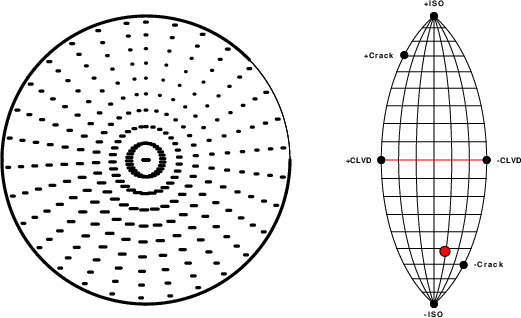
|
|
|
The best fit as a function of depth is given in the following figure:

|
|
|
The comparison of the observed and predicted waveforms is given in the next figure. The red traces are the observed and the blue are the predicted. Each observed-predicted component is plotted to the same scale and peak amplitudes are indicated by the numbers to the left of each trace. A pair of numbers is given in black at the right of each predicted traces. The upper number it the time shift required for maximum correlation between the observed and predicted traces. This time shift is required because the synthetics are not computed at exactly the same distance as the observed and because the velocity model used in the predictions may not be perfect. A positive time shift indicates that the prediction is too fast and should be delayed to match the observed trace (shift to the right in this figure). A negative value indicates that the prediction is too slow. The lower number gives the percentage of variance reduction to characterize the individual goodness of fit (100% indicates a perfect fit).
The bandpass filter used in the processing and for the display was
cut o DIST/3.3 -20 o DIST/3.3 +50 rtr taper w 0.1 hp c 0.03 n 3 lp c 0.10 n 3

|
|
|
A check on the assumed source location is possible by looking at the time shifts between the observed and predicted traces. The time shifts for waveform matching arise for several reasons:
Time_shift = A + B cos Azimuth + C Sin Azimuth
The time shifts for this inversion lead to the next figure:

The derived shift in origin time and epicentral coordinates are given at the bottom of the figure.
The focal mechanism was determined using broadband seismic waveforms. The location of the event and the and stations used for the waveform inversion are shown in the next figure.

|
|
|
The program wvfmtgrd96 was used with good traces observed at short distance to determine the focal mechanism, depth and seismic moment. This technique requires a high quality signal and well determined velocity model for the Green functions. To the extent that these are the quality data, this type of mechanism should be preferred over the radiation pattern technique which requires the separate step of defining the pressure and tension quadrants and the correct strike.
The observed and predicted traces are filtered using the following gsac commands:
cut o DIST/3.3 -20 o DIST/3.3 +50 rtr taper w 0.1 hp c 0.03 n 3 lp c 0.10 n 3The results of this grid search over depth are as follow:
MT Program H(km) Mxx(dyne-cm) Myy Mxy Mxz Myz Mzz Mw Fit WVFMTGRD96 1.0 -0.301E+22 -0.116E+22 0.195E+22 0.108E+23 -0.490E+22 0.417E+22 4.0007 0.7758 WVFMTGRD96 2.0 -0.298E+22 -0.114E+22 0.193E+22 0.685E+22 -0.296E+22 0.412E+22 3.8876 0.7161 WVFMTGRD96 3.0 -0.243E+22 -0.927E+21 0.157E+22 0.556E+22 -0.240E+22 0.335E+22 3.8277 0.6461 WVFMTGRD96 4.0 -0.208E+22 -0.927E+21 0.148E+22 0.478E+22 -0.208E+22 0.301E+22 3.7873 0.5987 WVFMTGRD96 5.0 -0.778E+21 -0.102E+22 0.128E+22 0.455E+22 -0.194E+22 0.180E+22 3.7516 0.5744
The best solution is
WVFMTGRD96 1.0 -0.301E+22 -0.116E+22 0.195E+22 0.108E+23 -0.490E+22 0.417E+22 4.0007 0.7758
The complete moment tensor decomposition using the program mtinfo is given in the text file MTGRDDCinfo.txt. (Jost, M. L., and R. B. Herrmann (1989). A student's guide to and review of moment tensors, Seism. Res. Letters 60, 37-57. SRL_60_2_37-57.pdf.
The P-wave first motion mechanism corresponding to the best fit is
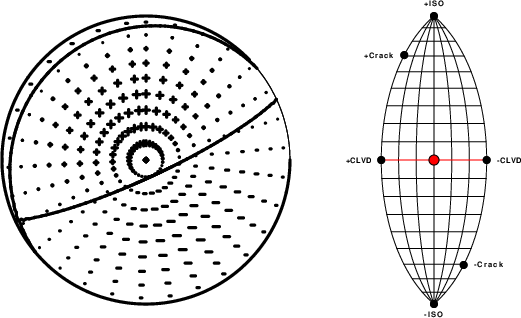
|
|
|
The best fit as a function of depth is given in the following figure:
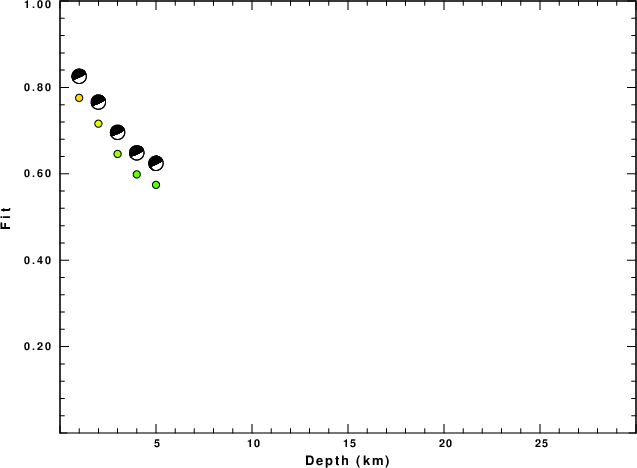
|
|
|
The comparison of the observed and predicted waveforms is given in the next figure. The red traces are the observed and the blue are the predicted. Each observed-predicted component is plotted to the same scale and peak amplitudes are indicated by the numbers to the left of each trace. A pair of numbers is given in black at the right of each predicted traces. The upper number it the time shift required for maximum correlation between the observed and predicted traces. This time shift is required because the synthetics are not computed at exactly the same distance as the observed and because the velocity model used in the predictions may not be perfect. A positive time shift indicates that the prediction is too fast and should be delayed to match the observed trace (shift to the right in this figure). A negative value indicates that the prediction is too slow. The lower number gives the percentage of variance reduction to characterize the individual goodness of fit (100% indicates a perfect fit).
The bandpass filter used in the processing and for the display was
cut o DIST/3.3 -20 o DIST/3.3 +50 rtr taper w 0.1 hp c 0.03 n 3 lp c 0.10 n 3
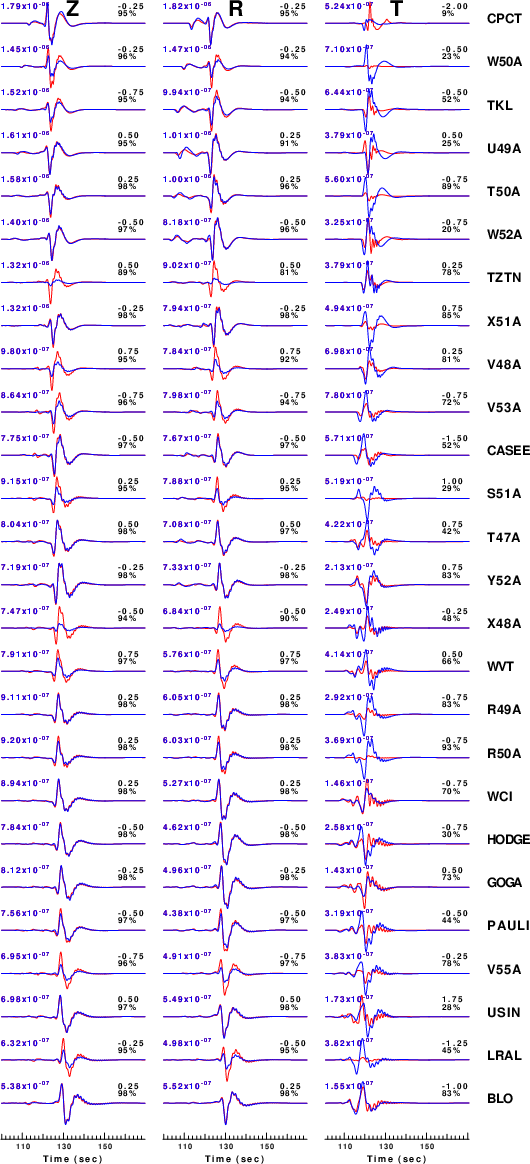
|
|
|
A check on the assumed source location is possible by looking at the time shifts between the observed and predicted traces. The time shifts for waveform matching arise for several reasons:
Time_shift = A + B cos Azimuth + C Sin Azimuth
The time shifts for this inversion lead to the next figure:
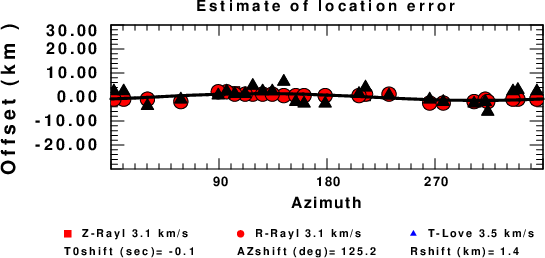
The derived shift in origin time and epicentral coordinates are given at the bottom of the figure.
The focal mechanism was determined using broadband seismic waveforms. The location of the event and the and stations used for the waveform inversion are shown in the next figure.

|
|
|
The program wvfmtgrd96 was used with good traces observed at short distance to determine the focal mechanism, depth and seismic moment. This technique requires a high quality signal and well determined velocity model for the Green functions. To the extent that these are the quality data, this type of mechanism should be preferred over the radiation pattern technique which requires the separate step of defining the pressure and tension quadrants and the correct strike.
The observed and predicted traces are filtered using the following gsac commands:
cut o DIST/3.3 -20 o DIST/3.3 +50 rtr taper w 0.1 hp c 0.03 n 3 lp c 0.10 n 3The results of this grid search over depth are as follow:
MT Program H(km) Mxx(dyne-cm) Myy Mxy Mxz Myz Mzz Mw Fit WVFMTGRD96 1.0 -0.271E+22 -0.378E+22 0.482E+21 0.127E+23 0.139E+22 0.649E+22 4.0298 0.9366 WVFMTGRD96 2.0 -0.385E+22 -0.434E+22 0.380E+21 0.730E+22 -0.196E+22 0.819E+22 3.9439 0.8458 WVFMTGRD96 3.0 -0.323E+22 -0.365E+22 0.319E+21 0.613E+22 -0.165E+22 0.688E+22 3.8935 0.7199 WVFMTGRD96 4.0 -0.252E+22 -0.288E+22 0.529E+21 0.503E+22 -0.166E+22 0.540E+22 3.8337 0.6308 WVFMTGRD96 5.0 -0.118E+22 -0.185E+22 0.620E+21 0.471E+22 -0.165E+22 0.303E+22 3.7697 0.5853
The best solution is
WVFMTGRD96 1.0 -0.271E+22 -0.378E+22 0.482E+21 0.127E+23 0.139E+22 0.649E+22 4.0298 0.9366
The complete moment tensor decomposition using the program mtinfo is given in the text file MTGRDDEVinfo.txt. (Jost, M. L., and R. B. Herrmann (1989). A student's guide to and review of moment tensors, Seism. Res. Letters 60, 37-57. SRL_60_2_37-57.pdf.
The P-wave first motion mechanism corresponding to the best fit is
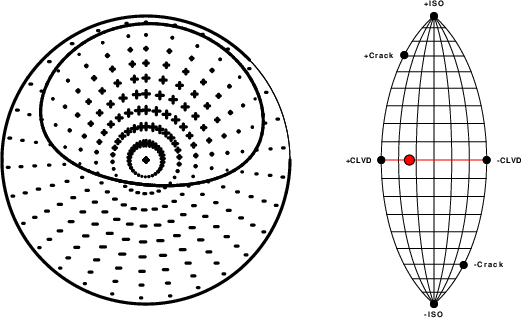
|
|
|
The best fit as a function of depth is given in the following figure:

|
|
|
The comparison of the observed and predicted waveforms is given in the next figure. The red traces are the observed and the blue are the predicted. Each observed-predicted component is plotted to the same scale and peak amplitudes are indicated by the numbers to the left of each trace. A pair of numbers is given in black at the right of each predicted traces. The upper number it the time shift required for maximum correlation between the observed and predicted traces. This time shift is required because the synthetics are not computed at exactly the same distance as the observed and because the velocity model used in the predictions may not be perfect. A positive time shift indicates that the prediction is too fast and should be delayed to match the observed trace (shift to the right in this figure). A negative value indicates that the prediction is too slow. The lower number gives the percentage of variance reduction to characterize the individual goodness of fit (100% indicates a perfect fit).
The bandpass filter used in the processing and for the display was
cut o DIST/3.3 -20 o DIST/3.3 +50 rtr taper w 0.1 hp c 0.03 n 3 lp c 0.10 n 3

|
|
|
A check on the assumed source location is possible by looking at the time shifts between the observed and predicted traces. The time shifts for waveform matching arise for several reasons:
Time_shift = A + B cos Azimuth + C Sin Azimuth
The time shifts for this inversion lead to the next figure:

The derived shift in origin time and epicentral coordinates are given at the bottom of the figure.
(Return to selection section) (Return to selection section)
The CUS.model used for the waveform synthetic seismograms and for the surface wave eigenfunctions and dispersion is as follows:
MODEL.01 CUS Model with Q from simple gamma values ISOTROPIC KGS FLAT EARTH 1-D CONSTANT VELOCITY LINE08 LINE09 LINE10 LINE11 H(KM) VP(KM/S) VS(KM/S) RHO(GM/CC) QP QS ETAP ETAS FREFP FREFS 1.0000 5.0000 2.8900 2.5000 0.172E-02 0.387E-02 0.00 0.00 1.00 1.00 9.0000 6.1000 3.5200 2.7300 0.160E-02 0.363E-02 0.00 0.00 1.00 1.00 10.0000 6.4000 3.7000 2.8200 0.149E-02 0.336E-02 0.00 0.00 1.00 1.00 20.0000 6.7000 3.8700 2.9020 0.000E-04 0.000E-04 0.00 0.00 1.00 1.00 0.0000 8.1500 4.7000 3.3640 0.194E-02 0.431E-02 0.00 0.00 1.00 1.00
Thanks also to the many seismic network operators whose dedication make this effort possible: University of Nevada Reno, University of Alaska, University of Washington, Oregon State University, University of Utah, Montana Bureau of Mines, UC Berkeley, Caltech, Saint Louis University, University of Memphis, the Oklahoma Geological Survey, TexNet, the Iris stations and other networks.